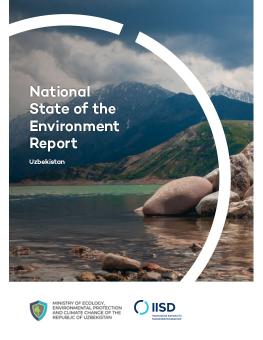
National State of the Environment Report: Uzbekistan
A healthy environment and its sustainable management are critical for citizens' well-being and supporting Uzbekistan's growing economy. The National State of the Environment Report (NSoER) is a comprehensive document that provides a snapshot of current environmental trends in Uzbekistan's socio-economic development for citizens, experts, and policy-makers. This report was prepared with the support of the United Nations Economic Commission for Europe, the United Nations Environment Programme (UNEP), and the Food and Agriculture Organization of the United Nations, along with financial support from the Global Public Goods and Challenges Programme Cooperation Agreement between the European Commission and UNEP.
-
A decade of environmental change is captured in the recent National State of the Environment Report of Uzbekistan.
-
The National State of the Environment Report is a comprehensive document that provides a snapshot of current environmental trends in Uzbekistan's socio-economic development for citizens, experts, and policy-makers.
-
Decade of trends for critical environmental issues, including air, water, and biodiversity, are reviewed in the recent National State of the Environment Report.
The analyzed environmental trends need to inform decision making and improve citizen engagement in natural resource management and environmental protection. This report thus aims to connect actions creating drivers and pressures influencing the state of the environment and relevant responses to address environmental challenges.
Our approach uses the Drivers– Pressures–State–Impacts–Responses (DPSIR) framework to draw connections between the state of the environment and the drivers and pressures on the environment. The framework brings together five critical elements of development in a connected framework to integrate the causes of environmental degradation (as well as environmental improvements) into a chain of causes and consequences. The DPSIR framework provides a suitable model for describing the interaction between human activities and the environment.
Based on the application of the DPSIR framework, the NSoER team, with the participation of stakeholders, identified the specific drivers, pressures, and components of the environment, such as atmospheric air, water resources, land, and specific ecosystems.
Participating experts
You might also be interested in
December 2024 | Carbon Minefields Oil and Gas Exploration Monitor
In November 2024, 23 oil and gas exploration licences were awarded across five countries, with Russia granting the licences that account for the largest portion of embodied emissions.
November 2024 | Carbon Minefields Oil and Gas Exploration Monitor
In October 2024, 20 oil and gas exploration licences were awarded across three countries, with a significant portion granted by Brazil.
Good COP? Bad COP?: Food systems at COP29
The 29th United Nations Climate Conference (COP 29) in Baku failed to build on the notable progress made on food systems at COP 28. However, it wasn't all doom and gloom.
Ending Export Credits for Oil and Gas: How OECD countries can end 2024 with a climate win
For a year now, Organisation of Petroleum Exporting Countries (OECD) governments have been negotiating an agreement that could put an end to oil and gas export finance. Following the acrimony in Baku, this would be a very real way for the OECD to show policy coherence, respond to calls from the poorest countries to stop subsidizing fossil fuels, and shift public finance to solutions.